I hear these are the scope mounts the Space Force will be getting on their modified HK G11s.
Earlier this year, Black Collar Arms, partially owned by TTAG’s own Jeremy S, released their ultra-premium one piece forged carbon fiber scope mounts. These mounts are made for Black Collar by McVick manufacturing out of Oklahoma.
It’s lauded as the same technology developed by Lamborghini and used in several key structural components of their vehicles (suspension arms, spaceframe, etc) as well as by Calloway Golf in their fanciest club heads. I don’t care. I’m not a car dude and golf is a good walk spoiled.
But a cool looking, rock-solid scope mount — allegedly the stiffest on the market — that only weighs 5.2oz? Jeremy, sir, you have my attention. And no, that’s not a misprint. The mount weights a mere 5.2oz.
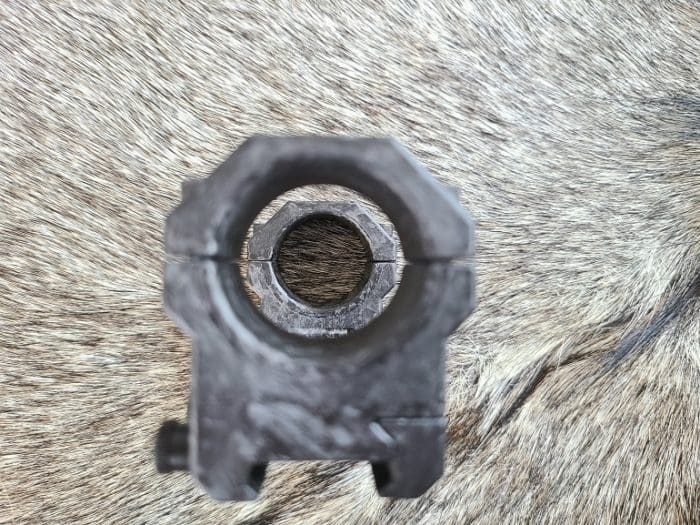
I don’t really like the term “forged” for this type of manufacturing, but I don’t know what else exactly to call it. That’s what Black Collar calls it, because that’s what the industry calls it, and it’s different enough from the layering and wrapping pattern we see with other carbon fiber items to just leave it at “forged” and call it a day. After all, it is compressed into shape like you’d smash a lump of metal rather than simply laid up in a mold.
When it comes to durability, there should have never been any question about the mounts. Simple materials science would explain that these mounts will be as or more durable than other premium mounts on the market.
When Jeremy told me his plans to bash a perfectly good scope in order to prove the mounts were good, I expressed the opinion that this event would prove little. After all, smart people already knew the scope itself is the weak link, and stupid people would still be stupid. So there were zero surprises when, after destroying a scope by smashing it with a mallet, the tube bent, the bell broke, the Picatinny rail ripped out of the gun and then out of a railroad tie, and the forged carbon fiber mount showed no signs of wear.
Durability was never a real issue, but there are other concerns.
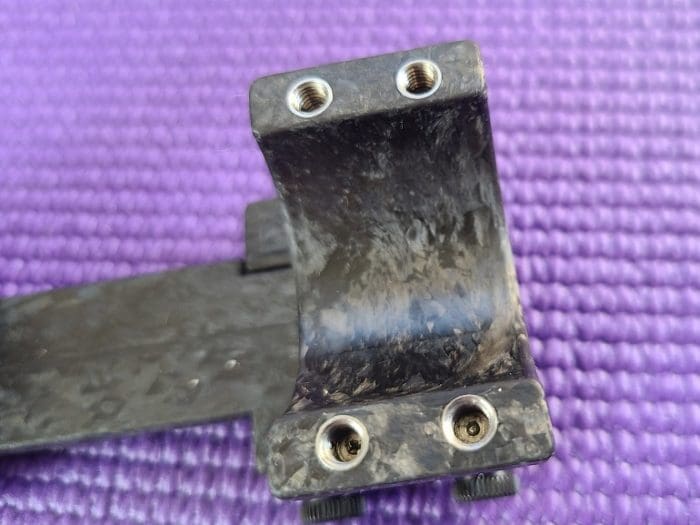
One of the worries with carbon fiber is that other materials have to interact with it, and mixing very different materials always presents challenges. One of the most obvious of these is the screws that hold the rings together and the screws that affix the mount to the receiver. Those screws are metal, and over time metal screws tend to route out thread holes in carbon fiber objects.
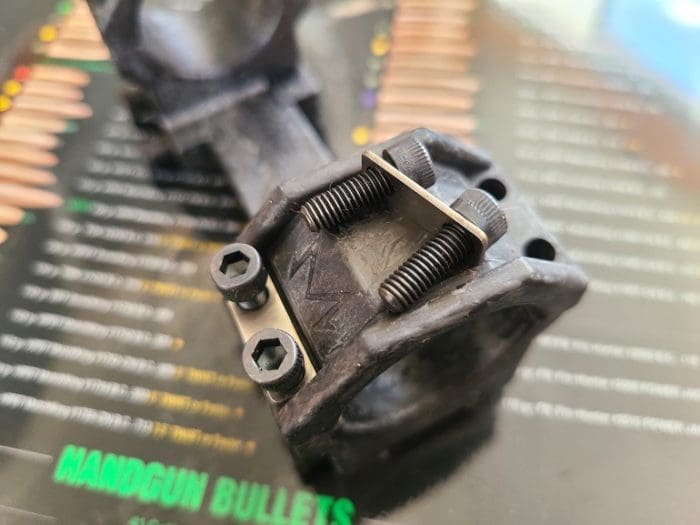
In the case of the ring caps on the ring bases, the solution provided by McVick is to insert metal thread sleeves into the body. These are screwed into from the top, with the screws passing through a simple metal bracket.

The mount is held to the receiver based on a standard 1913 Picatinny rail and it locks down with four bolts. Simple washers keep a good, even pressure on the squeezy parts.
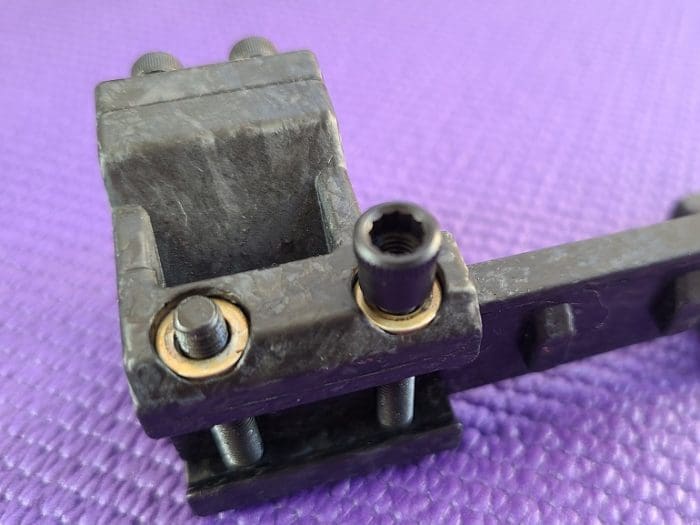
To test how well these mixed materials play with each other, I performed a prolonged, but relatively easy test. I torqued the ring caps to the specified 17 inch-pounds and set the mount in a deep freeze. Sometime during the day, I took it out and measured it with my Brown and Sharpe calipers. I did this every day for a month.
Physics is physics, and different metals expand and contract differently. That said, using my manual calipers, I was not able to determine any difference in height, length, or width, ring diameter, or any other dimension I could think of when the rings were frozen vs. thawed.
The widest temperature range from frozen to thawed over that month was well over 100 degrees. When the mount wasn’t in the freezer, it lived outside here in Central Texas. It didn’t rain that month (at all), but it did get lots and lots of sun. No damage was apparent.

I also set an AR-15 SBR upper receiver with the mount attached inside the chest freezer. The results were the same as with every other mount I’ve ever put on any other AR receiver, but with a slight twist.
The first time I did it, I performed my standard test mount practice of turning a torx wrench against the screws until it felt like I was going to bend the wrench. That turned out to be at 34 inch-pounds. I know that because after all of the testing was done I got the original box and found that the base screws were supposed to be tightened to 25 inch-pounds. So I did a quick test before backing the screws out to where they belonged.
At 34 inch-pounds, I pulled the receiver from the freezer, gave the mount a strong whack with a rubber mallet, and measured the movement. Maybe it moved 1,000th of an inch. Maybe.
When I backed off to the correct base screw torque rating and repeated the freeze/thaw/mallet test, the mount moved to the back of the rail section. I did the same thing, but waited until both had thawed. No discernable movement. This is what I am used to with other mounts. Long story short, check your mount if you are in negative 30 degree weather for 10 or more hours. Also, reconsider your life choices. Plus you should install your mounts or rings — any mounts or rings — pressed as far forward within the Picatinny slots as possible so even if they don’t grip as hard as the Black Collar setup here, they can’t move under recoil.
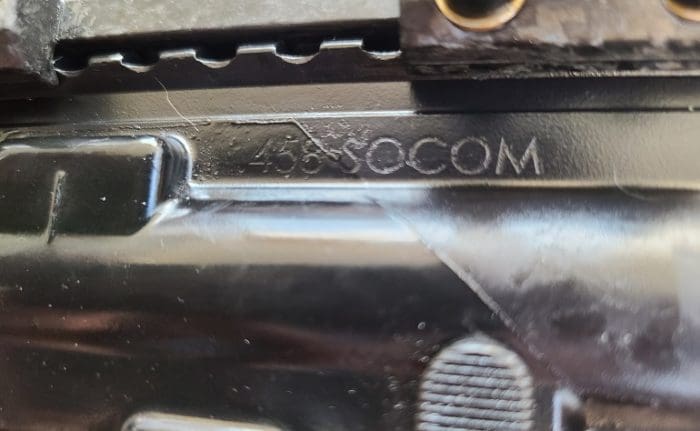
Since I’m still not able to move around too much from my recent nephrectomy, I asked a buddy of mine to do some shooting. First was 200 rounds through a .458 SOCOM rifle. (I provided the ammo. Ouch.) This was with a Nightforce SHV 3-10X42mm scope mounted in the rings. He then removed the scope and mount and put it on a bolt action rifle chambered in .308 Winchester.
Neither rifle moved the scope in the rings. The rings also didn’t scratch, discolor, or otherwise mar the scope or the AR-15 receiver. That was a particularly nice feature.
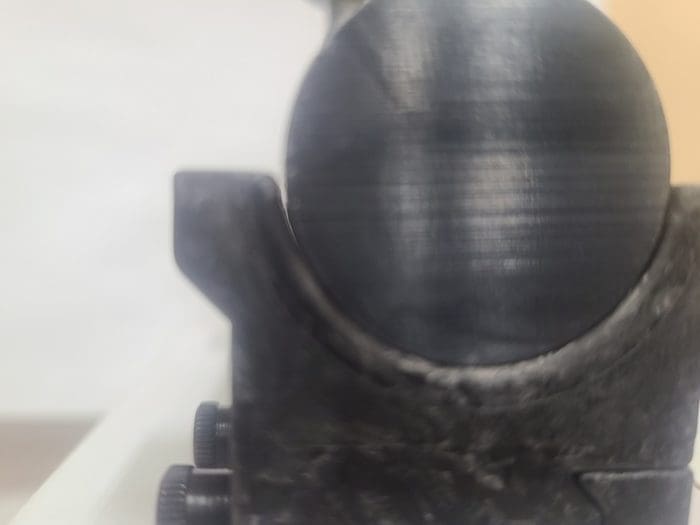
I also wanted to see how round the rings were, or to see if they needed significant lapping. When I set the 30mm lapping bar in the rings, I noticed there was a bit of room on the side. Measuring the closed, but not torqued tight rings, I found they measured 30.5mm.
With a scope in the rings and the rings torqued to spec, I was unable to find any gap anywhere with a feeler gauge at even 1,000th of an inch. I tried this with a Leupold 30mm scope that actually measured 29.93mm as well as a Vortex 30mm scope that measured 29.95mm.
I suspected the answer, but got in contact with the manufacturer, Mr. McVick himself, to talk to him about why the rings were slightly oversized. The answer is simple: carbon fiber doesn’t flex like aluminum.
As I found when I torqued the rings down to the correct spec, they snugged up tight against the scope tubes despite this material being stiffer than aluminum. Mr. McVick left the rings slightly oversized so that they wouldn’t mark or crush the tubes underneath them, plus the ever-present tension on the hardware that’s provided by the rings acts as an extremely effective lock washer. No thread locker compound or actual lock washers needed.
Now, I don’t care if my scope is marked by the rings. Heck, it’s probably going to get all rattle-canned up anyway, but I understand if others do. Keeping the hardware tight is always an appreciated bonus, though.
Between the months of testing I’ve put into these rings, including 30 different freeze/thaw cycles, as well as the ridiculous tests Jeremy put it through, I’d say any real concerns with these mounts have been put to rest.

What we are left with are really cool looking mounts that stand up to use and abuse in a wide range of temperatures. They take a beating. They also do everything a high quality mount is supposed to do: they hold the scope in place with rock solid tenacity, and they do it with the added benefit of not marking up the tube or the receiver. The huge benefit is the fact that these mounts have a full footprint, with lots of ring contact, and are incredibly stiff, and yet they weigh next to nothing.
Specifications: Black Collar Arms Forged Carbon Fiber One Piece Scope Mount
Length: 4.5″
Centerline height: 1.18″ (30mm)
Weight: 5.2 oz
Ring size: 30mm (34mm also available)
Price: $399.99
Overall * * * * *
Yay innovation. The future is now. The Black Collar forged carbon fiber scope mounts are extremely light weight, practically temperature insensitive, impossibly strong, and they do everything you’d want a good mount to do. If you’re on a tight budget, this is not the mount for you. If ultra light weight is a plus yet you still need the grip and stiffness of a full footprint mount, this is the mount for you. If your thing is next-level gear, this is the only mount for you.

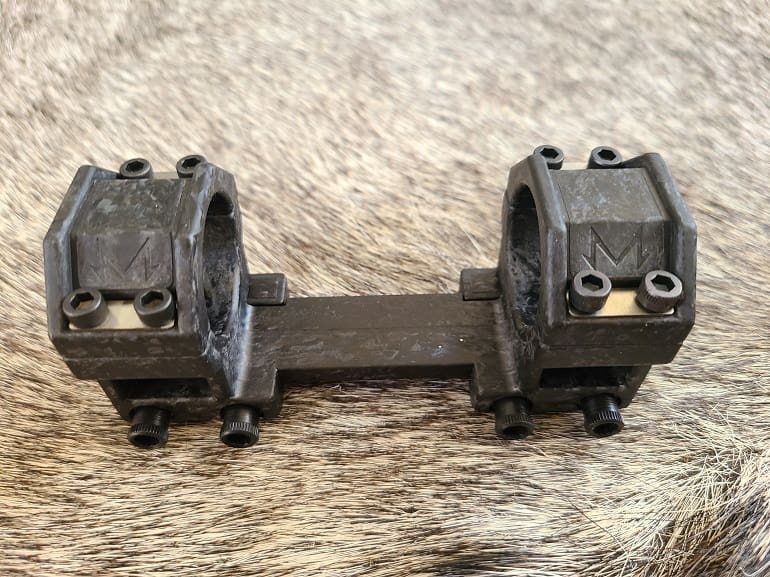



I like carbon fiber, but at 5.4 oz i can get the Scalarworks leap mount with QD and integral scope leveler for less money and the same weight.
The LEAP is a sweet mount; I couldn’t criticize any aspect of it if I wanted to. However, I might suggest as reasons to consider our forged carbon fiber mount instead: increased stiffness, increased strength, increased scope tube grip, reduced likelihood of hardware loosening due to fluctuations in temperature or from vibration, completely different aesthetic, more appropriate height for a precision rifle rather than being taller for an AR style use, and also non-cantilever which may also be more appropriate correct placement on a precision rifle. MSRP is the same as ours at $399.99 and our weight is 5.2 ounces, BTW, not 5.4. Not that I’d nitpick two tenths of an ounce haha 😉
Good points. I appreciate the feedback.
You can get an Aero precision mount at less than 3 oz for $60.00. 4 bills is ridiculous
SMDH
are they as strong as this? or are they milled-out and flimsy?
And that’s also not a mount I would put on a gun. Maybe a .22LR AR. A skeletonized aluminum cantilever mount is an absolute no-go for a precision rifle.
@jwtaylor
I understand you’re referencing a specific application, but I find it as an overarching comment to be a gross oversimplification.
And it is an interesting assessment, as my .223 Wylde po-boy’s setup with that $60 Aero mount (lapped), Primary Arms 1-6 LPVO ACSS, $40 no-name blem upper (lapped) and X-Caliber barrel didn’t get that memo. It holds zero between trips to the range (using the same lot ammo, and if temps/humidity/pressure are more or less the same) and keeps my groups well inside 1″ @ 100 using 69gr BTHPs. It’s usually a 1/2″ rifle when I don’t pull a shot.
Either way, options are good, and I have no qualms about having a new one, regardless of expense. There is an application for it and its benefits will find its niche.
Casey, we probably have different standards for what 1/2″ means. I don’t think I’ve ever reviewed an AR15 by any manufacturer at any price that shoots consistent half inch groups with factory ammo.
When times return to normal, I could buy a whole rifle for the cost of this mount.
Badger Ordinance A-MAXX 50 rings were pretty much the most expensive rings / mount I ever owned. $160 ish, for a 2K scope.
If you think they are too heavy then you need to grow some muscles.
Bigger muscles aren’t going to help you keep under weight limits for competition.
Wow that is quite a price! However if you’re going to be carrying your gun for a lengthy amount of time. It might be worth it. And thanks for the review.
With the added inserts and washers, why not just use a hard polymer and save the price tag?
Polymer wouldn’t be strong enough or stiff enough for a serious scope mount. The forged CF is multiple orders of magnitude stronger. Heck, it’s stronger than if you machined the same piece from titanium and it’s as stiff as if you machined it from steel.
“Yeah baby, she’s ugly but she sho can cook!” Jimmy Soul
$400 scope mount…
That’s more than I paid for my scope.
Hell that’s more than I paid for my scope + mount.
The iron sights on an AK are marked to 800 meters. I see no need to install a scope if you purchase the right firearm.
The front sight post is wider than the target at that range.
@800meters the broad side of a barn is not covered by the front sight. You’ve got to pick the right the right target.
Sharpen your sights. 🙂
The human eye is good at finding symmetry in things. Apply the bilateral symmetry of the front sight post.
You can do it.
I get it, it is a really REALLY nice mount. It performs REALLY well. But honestly, $400 for just a mount is too much.
I get it, Jeremy works here, great advertisement for your company and make some extra money but this is preaching to the wrong crowd. I can only see a slim NEED for this mount. Everything else is a buy because you can afford it.
Now don’t get me wrong, I’m not just complaining because I’m poor and cant have nice things. I’m just not big on spending money just for the sake of spending.
Much like Cabot 1911’s, the NEED has left the building in place of the because we can for enough money.
Its cool, its strong, fantastic.
Lets not keep advertising it every 2 weeks trying to get buyers for something Jeremy sunk a bunch of money into that has a very small return on investment due to its tiny buyer window.
As a sniper in Iraq I would take it, as someone hunting deer in Ohio, wasteful spending.
We’ll do some more popular mounts soon — red dot risers, an AR-style cantilever, some rings. McVick started with this model in order to create the stiffest, most solid scope mounting platform on the market. And they succeeded. With the popularity of SPUHR, MPA, Seekins, Hawkins, American Rifle Company, Scalarworks, and other high-end mounts for these markets, many of which start at about $400 and can go well up from there, I don’t agree that it’s as niche as you may think. Deer hunting in Ohio, sure, it may not make sense. But the long range precision, PRS, long range hunting, tactical, and “sniper in Iraq” audiences are larger than you may think. Scopes with MSRPs over $2,000 (many WELL over) are incredibly popular. That high-end glass is often put in a high-end mount, and much of that market starts around $350 and goes well up.
Nice to know someone can manufacture the very best. Congrats!
but for us poor boys, we squint at spending 100 bux on a scope mount. Maybe when I hit the lottery………..
Yessir, I know what you mean and I’m literally in your shoes — we sell ’em but I can’t afford one for myself haha.
Also, in reply to Bob up above, I just wanted to say that the reason Black Collar loaned a mount to JWT for review is because he doesn’t give a flying F what brand name is on the side of whatever it is that he’s reviewing or the fact that Jeremy is a co-owner of Black Collar Arms. He’s going to test the freakin’ hell out of whatever it is and then he’s going to tell it how it is no matter what. Frankly, every writer here has pissed off friends and acquaintances and companies that “thought we were cool” with the brutally honest reviews that the TTAG brand was built on. Seems like a lot of people don’t believe that until TTAG reviews something of theirs and includes all of the bad and the ugly or full-on gives it a crappy rating and they’re like “whoa, WTF, but we’re friendly to each other and I hunted with you once!” and TTAG is like “yeah, but I told you the deal with our reviews” and they’re still just shocked LOL. JWT got this mount to review precisely because his reputation for thorough testing and honesty is rock solid and Black Collar wants reviews like that out in the public domain to give people confidence in the product. And we’re confident enough to put it in JWT’s (and others’) hands.
Cheers,
Jeremy S.
BCA,
Damned if that ain’t the truth. I still have an unfortunate number of people who I thought were friends not talk to me after my reviews. Even generally positive reviews, but they don’t get five stars or there’s one thing about it that I didn’t like (such as calling these mounts “forged”) get people all butthutt.
Even worse is when I tell people “I’m not going to like that” and they send it to me to review anyway. They’re always shocked when I write that I don’t like it.
Oddly enough, some of the people I don’t seem to get along with get the better reviews. I don’t think I’ve ever had a more than 2 minute conversation with Bill Wilson where I didn’t end up in a (polite) argument. But he made a hell of a company and has very strict standards. And I guess, if I have to say it, I usually come around to realizing he was right in the first place. So his stuff gets good reviews. John Stewart of Kiote Rifles is the most stubborn human being I know. But man, he builds his guns right with zero compromises. So.. good reviews.
In case the readers haven’t noticed, I generally just review stuff I’m interested in now, not just whatever gets assigned. And not dealing with the “friends” in the industry is one of the reasons.
I helped fund some of the State of Texas’ carbon fiber multi functional material labs back in the 1990s and early 2000s. I know a little about it, and more importantly, I got to talk to the people who know a whole lot about it. That’s why there was no question this mount would perform, as long as the manufacturing process was right. In the end, that’s all I was really testing.
Jeremy, dont waste your time… you are arguing with people who think the scopes they sell in blister packages next to the doe urine scent at the local sporting goods store are the benchmark for “quality”.
Pearls before swine.
You mentioned SPUHR mounts above, would this be reasonably comparable as far as performance/strength to one of those? Or is the main benefit the weight savings?
Oooh, the Space Marines use ’em. I gotta get one.
Now, please use this tech to make a stock.
How about a upper and lower for ARs? I guess that’ll be around 4 grand each ?
And then you’d have an $8,000 plastic rifle with a $4,500 scope/plastic lenses, sitting in a $400 plastic scope mount.
Cheap whiskey.
Yeah, cost goes up as size goes up. We’ll be releasing other products co-designed between us and McVick, but I’m not confident there will be anything as large as a stock (unless it’s a super little minimalist AR one that basically just clamps to the end of a buffer tube, which isn’t in the plans but might be cool) or a receiver any time soon. Just too cost prohibitive.
And it already exists.
Is this like when commercials on TV are shown a certain number of times for a fee? Seeing as how this Black Collar Arms post has now shown several times, more or less:
https://www.thetruthaboutguns.com/?s=Black+Collar+Arms
You should see how many posts come up when you search Remington, Springfield, SIG, ATF, Trump, etc! Crazy stuff. 😉
September 7th announcement.
Stupid people complained that it would be brittle.
November 20 Jeremy breaks a scope to prove it isn’t brittle.
Stupid people complained about stupid things, smarter people asked smarter questions.
November 30 JWT does more complete review focusing on those smarter questions.
enuf complains more.
People complain when there aren’t enuf gun and gear reviews then complain about the reviews.
Some people aren’t happy unless they are complaining.
Spent a lot of DoD funds injection molding PA 6/6 with 30% Carbon Fiber. Because Carbon Fiber is conductive, had to use ~250’F actual steel (Mold) temperature. Easy to tell if the temperature is right, as got a nice slick resin rich surface. Also able to almost duplicate 1018 CR steel properties, the big exception being that repeated flexing would not bust the PA 6/6 30% CF long after a 1018 CR steel part would fail.
Soo If the parts are molded properly, can get 1018 CR type properties with about 1/3 the weight. Note that even 33% GF ZYTEL will match the properties of 7076 Aluminum; if molded properly; with about 2/3 the weight.
Nice, useful for military, me not so much. That mount cost more than my rifle, scope and a box of ammo ( pre-COVID-19 ) together.
So the Space Force isn’t going to be issued plasma rifles or phasers?
Sonsabitching recruiter lied, dang, to late now.
And it’s hi hi hee
For the kotex factory
Sound of your sizes loud and clear.
no one has canceled
if you don’t want to do larger parts like upper/lower receiver I guess quad rails are out. a grip is unnecessary. I can’t think of any other small high-stress parts that won’t get melted. how about an ultralight bolt carrier. they don’t get too hot. only other thing I can think of that could use weight reduction is a scope tube, but I think a lot of that weight is internal parts, and the tube is sort of thin. how about an ACOG body.
So JWT would you say the BCA mount is as good as a Spuhr mount? Same price, less weight? I understand that all the taquito slingers need to save up a months wages for their Mosin and the fist-waving of the Proletariat notwithstanding, this would be a more interesting side by side test to see if this BCA mount is actually better value for the money because of how much less it weighs.
I would pick the BCA over the Spuhr, no doubt. Not because of the weight and strength, but because of the ring contact and mount to receiver contact, and also because they look great and compliment a CF barrel well.
The reality is that these mounts, the LEAP mount, and a few others are excellent gear and will serve you well for the rest of your life, no matter your level of expertise and the amount you shoot. The differences in performance, even where they exist, will be unrealized at their fullest potential. Are you shooting on the moon where there’s a 500 degree temperature difference in your shooting environment? Because you’ll really see the difference there.
Until then (and I hope that’s soon) the great thing is that these mounts are the kind of gear that simply removes a problem from the chain of “things that can go wrong” with your shooting.
It looks really nice and all. But for AR height non quick release mounts, its hard to beat Aeroprecision.
Light, strong, tight tolerances, and reasonably priced.
I had never heard of ‘forged carbon fiber’ until I saw this article and suspected some kind of linguistic fuckery for a cheap manufacturing process. So I looked it up.
Apparently, forged composites were originally jointly-developed by Lamborghini and Calloway Golf for use in major car components and golf clubs. Not the cheap kind either.
Huh. Guess I jumped the gun, so to speak.
carbon fiber will not hold heat so i prefer carbon fiber it make me comfortable using my gun
Visit This!! I Brought my awesome speedloader at https://amzn.to/3l4yKQC